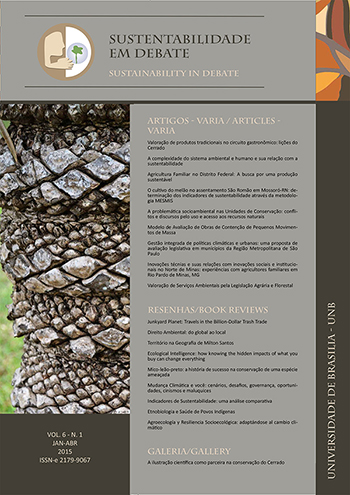Sustainability of melon cultivation in São Romão settlement in Mossoró/RN:
determination of indicators by the MESMIS methodology
DOI:
https://doi.org/10.18472/SustDeb.v6n1.2015.11720Keywords:
Agricultura sustentável, Indicadores de sustentabilidade, Assentamentos rurais, MESMIS, MelãoAbstract
Currently, agriculture is one of the most discussed topics in the theoretical field of sustainability. Debates regarding this issue are increasingly recurrent and put in question the model adopted from the post-war, the so-called green revolution. In the state of Rio Grande do Norte, the agricultural potential lies mainly in irrigated horticulture, where stands the agropolo Acu-Mossoró as one of the greatest watermelon producing regions of Brazil. The cultivation of watermelon, once dominated by large agricultural companies, is currently developed by agroecosystems whose management is characterized by family participation, including small farmers of rural settlements created by Incra. Aiming to assess the sustainability of this type of cultivation, was used the MESMIS methodology in the in São Romão settlement in Mossoró-RN, which is primarily engaged in the cultivation of irrigated melon. Seven critical points were determined and selected twenty-three indicators that directly affect the sustainability of the researched area.
Downloads
References
environments. Agriculture, Ecosystems and Environment, v. 93, p.1-24, 2002.
BUAINAIN, A. M. Agricultura familiar, agroecologia e desenvolvimento sustentável: questões
para debate. Brasília: IICA, 2006. 136 p.
COSTA, A. A. V. M. R. Error! Hyperlink reference not valid.. Revista de Ciências Agrárias, Lisboa,
v. 33, n. 2, p. 90-105, dez. 2010. Disponível em: <http://www.scielo.oces.mctes.pt/scielo.php?script=
sci_arttext&pid=S0871-018X2010000200009>. Acesso em: 18 out. 2012.
EMBRAPA ”“ EMPRESA BRASILEIRA DE PESQUISA AGROPECUÁRIA. Sistema Brasileiro de Classificação
de Solos. 2. ed. Rio de Janeiro: Embrapa Solos, 2006. 306 p.
EMPARN ”“ EMPRESA DE PESQUISA AGROPECUÁRIA DO RN. Monitoramento pluviométrico,
1992-2012. Disponível em: <http://www.emparn.rn.gov.br>. Acesso em: 12 jul. 2013.
GARCIA JR, A. R. A sociologia rural no Brasil: entre escravos do passado e parceiros do futuro.
Sociologias, Porto Alegre, v. 5, n. 10, p. 154-189, 2003.
IBGE ”“ INSTITUTO BRASILEIRO DE GEOGRAFIA E ESTATÍSTICA. Censo agropecuário 2006: Brasil,
grandes regiões e unidades da federação. Rio de Janeiro: IBGE, 2006. 777 p.
INCRA ”“ INSTITUTO NACIONAL DE COLONIZAÇÃO E REFORMA AGRÁRIA. Sistema de Informações
de Projetos de Assentamento ”“ SIPRA: Área do projeto, capacidade de assentamento, famílias
assentadas... Disponível em: <http://sipra.incra.gov.br/Projeto/Relatorios/default.asp>.
Acesso em: 12 ago. 2014.
LOPEZ-RIADURA, S.; MASERA, O.; ASTIER, M. Error! Hyperlink reference not valid.. Ecological
Indicators, v. 2, n. 1, p. 135-148, nov. 2002. Disponível em: <http://www.sciencedirect.com/
science/article/pii/S1470160X02000432>. Acesso em: 25 set. 2012.
MARZALL, K. Indicadores de sustentabilidade para agroecossistemas. (Dissertação de Mestrado).
Porto Alegre: Faculdade de Agronomia da Universidade Federal do Rio Grande do Sul, 1999.
224 p.
MASERA, O.; ASTIER, M.; LÓPEZ-RIDAURA, S. Sustentabilidad y Manejo de Recursos Naturales:
el marco de evaluación MESMIS. México: Mundi-Prensa, 1999. 109 p.
SCHNEIDER, S.; MATTEI, L.; CAZELLA, A. Histórico, caracterização e dinâmica recente do PRONAF.
In: SCHNEIDER, S. et. al. (Org.). Políticas públicas e participação social no Brasil rural. Porto
Alegre: UFRGS, 2004. p. 21-50.
SILVA, A. G. da. Trabalho e tecnologia na produção de frutas irrigadas no Rio Grande do Norte,
Brasil. In: CAVALCANTI, J. S. B.(Org.). Error! Hyperlink reference not valid.. Recife: Ed. Universitária
da UFPE, 1999. p. 317-352.
WANDERLEY, M. N. B. Agricultura Familiar e Campesinato: rupturas e continuidade. Estudos
Sociedade e Agricultura, Rio de Janeiro, n. 21, p. 42-61, 2003.
Downloads
Published
How to Cite
Issue
Section
License
SUSTAINABILITY IN DEBATE – Copyright Statement
The submission of original scientific work(s) by the authors, as the copyright holders of the text(s) sent to the journal, under the terms of Law 9.610/98, implies in the concession of copyrights of printed and/or digital publication to the Sustainability in Debate Journal of the article(s) approved for publication purposes, in a single issue of the journal. Furthermore, approved scientific work(s) will be released without any charge, or any kind of copyright reimbursement, through the journal’s website, for reading, printing and/or downloading of the text file, from the date of acceptance for publication purposes. Therefore, the authors, when submitting the article (s) to the journal, and gratuitous assignment of copyrights related to the submitted scientific work, are fully aware that they will not be remunerated for the publication of the article(s) in the journal.
The Sustainability in Debate Journal is licensed under Creative Commons License – Non-Commercial-No-Derivation Attribution (Derivative Work Ban) 3.0 Brazil, aiming at dissemination of scientific knowledge, as indicated on the journal's website, which allows the text to be shared, and be recognized in regards to its authorship and original publication in this journal.
Authors are allowed to sign additional contracts separately, for non-exclusive distribution of the works published in the Sustainability in Debate Journal (for example, in a book chapter), provided that it is expressed the texts were originally published in this journal. Authors are allowed and encouraged to publish and distribute their text online, following publication in Sustainability in Debate (e.g. in institutional repositories or their personal pages). The authors expressly agree to the terms of this Copyright Statement, which will be applied following the submission and publishing by this journal.





